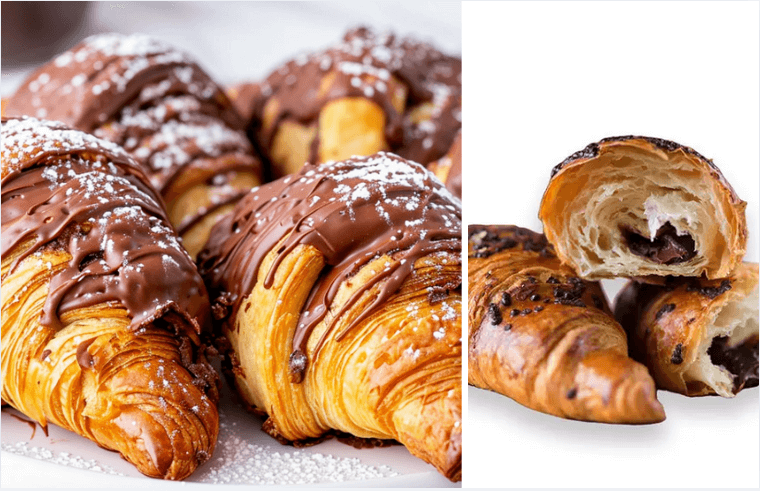Croissants are more than just a breakfast item; they’re a cultural icon representing the artistry of French baking. These flaky, buttery pastries have traveled far from their Parisian roots to become beloved worldwide. Whether you’re enjoying a traditional French croissant with a cup of coffee, savoring a chocolate croissant as a midday treat, or experimenting with modern twists like pistachio or almond croissants, there’s no denying their universal appeal. In this article, we’ll dive into the fascinating world of croissants, exploring their history, types, recipes, and more.
Biography Table: Quick Facts About Croissants
| Category | Details |
|---|---|
| Origin | Austria (Kipferl); popularized in France |
| Key Ingredients | Flour, butter, sugar, salt, yeast, milk |
| Calories | 230-500 per croissant (varies by type) |
| Popular Varieties | French, chocolate, almond, pistachio, ham and cheese |
| Dietary Options | Gluten-free croissants, low-calorie croissants |
| Cultural Impact | Iconic in French culture, global variations like Lidl croissant bags |
The Origin and Evolution of the Croissant
The croissant’s history is as rich and layered as the pastry itself. While it is synonymous with French cuisine, its origins trace back to Austria. The precursor to the croissant, called the “kipferl,” was a crescent-shaped pastry enjoyed in Vienna as early as the 13th century. It wasn’t until the late 18th century that the recipe made its way to France, where it evolved into the flaky, buttery delight we know today as the croissant.
The French perfected the art of lamination—the technique of folding butter into dough multiple times to create thin layers. Over time, the croissant became a symbol of French culture and sophistication, earning its place as a staple in bakeries worldwide. Today, you can find various interpretations of the croissant, from the classic French croissant to innovative creations like the jellycat croissant and the convenience-focused Lidl croissant bag.
What Makes a Croissant Irresistible?
A perfect croissant is a balance of flavor, texture, and aroma. Its defining characteristic is its flaky layers, achieved through a meticulous lamination process. The rich buttery flavor and golden-brown exterior make it a feast for the senses.
But what sets croissants apart from other pastries? The secret lies in the quality of ingredients and the skill of the baker. Authentic French croissants are made with just a few simple ingredients: flour, butter, sugar, salt, yeast, and milk. Yet, the technique of folding and rolling the dough is what creates its unique structure.
Modern variations, such as chocolate croissants and almond croissants, enhance this classic with fillings and toppings. These versions are especially popular for dessert lovers who crave a sweeter twist. Additionally, the rise of gluten-free croissants has made it possible for those with dietary restrictions to enjoy this iconic pastry without compromise.
Exploring Croissant Varieties: From Classic to Creative
French Croissant
The classic French croissant remains the gold standard for pastry lovers. Its simplicity highlights the quality of ingredients, making it a true showcase of traditional baking techniques. Pair it with a café au lait for an authentic Parisian breakfast experience.
Chocolate Croissant (Pain au Chocolat)
The chocolate croissant, known as “pain au chocolat” in France, is a square-shaped version filled with rich chocolate. This popular variation is perfect for those who enjoy a sweet start to their day or a decadent afternoon snack.
Almond Croissant
For an indulgent treat, almond croissants take center stage. These croissants are filled with almond cream (frangipane) and often topped with sliced almonds and powdered sugar. Their nutty, sweet flavor is a hit among pastry enthusiasts.
Pistachio Croissant
A modern twist on the classic, pistachio croissants are gaining popularity for their unique flavor profile. Filled with pistachio cream and sometimes adorned with chopped pistachios, this variety is both visually stunning and deliciously satisfying.
Ham and Cheese Croissant
Not all croissants are sweet! The ham and cheese croissant is a savory option that has become a lunchtime favorite. Filled with smoky ham and melted cheese, it’s a hearty and satisfying choice for those who prefer savory over sweet.

Making Croissants at Home: A Step-by-Step Guide
For those who love to bake, making croissants at home is a rewarding challenge. While it requires time and patience, the results are well worth the effort. Here’s a simplified version of the croissant recipe:
Ingredients
- 4 cups of all-purpose flour
- 1 cup of unsalted butter (cold)
- 2 teaspoons of salt
- 1/4 cup of sugar
- 2 1/4 teaspoons of instant yeast
- 1 cup of milk (warm)
Instructions
- Prepare the Dough: Mix the warm milk, sugar, and yeast in a bowl. Let it sit for 5 minutes until frothy. Add the flour and salt, then knead until the dough is smooth. Chill for 30 minutes.
- Laminate the Dough: Roll out the dough into a rectangle and layer it with cold butter. Fold and roll the dough multiple times to create thin layers. Chill between folds.
- Shape the Croissants: Roll out the dough and cut it into triangles. Roll each triangle into a crescent shape, starting from the wide end.
- Proof and Bake: Let the croissants proof until doubled in size. Bake in a preheated oven at 375°F (190°C) for 15-20 minutes or until golden brown.
For variations, you can add fillings like chocolate or almond cream before shaping the dough.
Fun Facts About Croissants
- Croissant Pronunciation: The correct French pronunciation is “krwah-SAHN,” though English speakers often say “kruh-SANT.”
- Croissant Calories: A classic butter croissant contains around 230-300 calories, but filled versions like chocolate or almond croissants can go up to 500 calories.
- Jellycat Croissant Plush: The croissant’s cultural impact extends beyond food! The Jellycat croissant plush toy is a whimsical nod to this beloved pastry, popular among children and adults alike.
- 7 Days Croissant: The 7 Days croissant, a pre-packaged version, offers a convenient option for enjoying this treat on the go. It’s available in various flavors, including chocolate and vanilla.
- Lidl Croissant Bag: Lidl supermarkets offer croissant bags that make it easy to enjoy multiple croissants at an affordable price—perfect for sharing or meal prepping.
Healthier Alternatives and Dietary Options
As the demand for healthier and dietary-inclusive options grows, bakers have introduced alternatives to the traditional croissant:
Gluten-Free Croissants
For those with gluten sensitivities or celiac disease, gluten-free croissants are now widely available. Made with alternative flours like almond or rice flour, these croissants offer the same flaky texture without gluten.
Low-Calorie Options
While traditional croissants are high in butter and calories, some bakers offer low-calorie versions made with less butter or whole-grain flour. These options are perfect for health-conscious individuals who still want to indulge.
Tips for Storing and Serving Croissants
To enjoy croissants at their best, follow these tips:
- Storage: Store croissants in an airtight container at room temperature for up to two days. For longer storage, freeze them and reheat in the oven.
- Serving: Warm croissants in the oven at 350°F (175°C) for 5-7 minutes to restore their flaky texture. Serve with jam, butter, or a hot beverage for a complete experience.
The Croissant’s Global Influence
Though rooted in French tradition, croissants have become a global phenomenon. From local bakeries in New York to supermarkets in Tokyo, their presence is universal. The versatility of croissants, from the classic French version to creative adaptations like pistachio or jellycat-inspired varieties, ensures they remain a timeless favorite.
Conclusion
The croissant is more than a pastry—it’s a culinary masterpiece that has stood the test of time. From its Austrian origins to its French refinement, the croissant has become a versatile and beloved treat worldwide. Whether you’re indulging in a classic French croissant, exploring unique flavors like pistachio or almond, or opting for a gluten-free version, there’s a croissant’s for everyone. With its rich history, endless variations, and universal appeal, the croissant continues to be a symbol of joy and indulgence for food lovers around the globe.











Leave a Reply